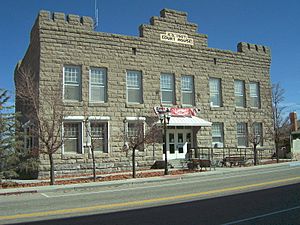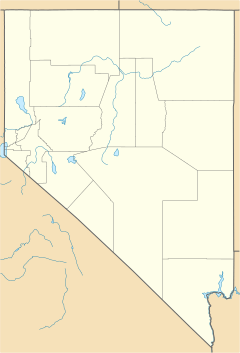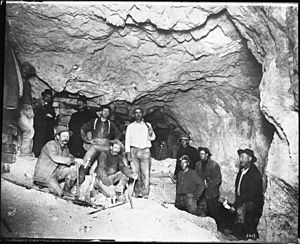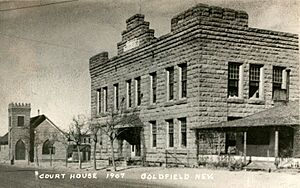Goldfield, Nevada facts for kids
Quick facts for kids
Goldfield
|
|
|---|---|

Esmeralda County Courthouse in Goldfield
|
|
| Country | |
| State | |
| County | Esmeralda |
| Founded | 1902 |
| Named for | Gold |
| Area | |
| • Total | 1.48 sq mi (3.84 km2) |
| • Land | 1.48 sq mi (3.84 km2) |
| • Water | 0.00 sq mi (0.00 km2) |
| Elevation | 5,686 ft (1,733 m) |
| Population
(2020)
|
|
| • Total | 225 |
| • Density | 151.92/sq mi (58.66/km2) |
| Time zone | UTC−8 (PST) |
| • Summer (DST) | UTC−7 (PDT) |
| ZIP code |
89013
|
| Area code(s) | 775 |
| FIPS code | 32-28900 |
| GNIS feature ID | 854468 |
Goldfield is a small town in Esmeralda County, Nevada. It is the main town for the county. Today, it is a census-designated place, which means it's a community that the government counts for population, but it doesn't have its own local government.
Goldfield became a very busy place, known as a "boomtown," in the early 1900s. This happened because a lot of gold was found there. Between 1903 and 1940, the mines in Goldfield produced gold worth over $86 million!
A big fire in 1923 destroyed most of the town. However, some buildings survived and are still standing today. These include the Goldfield Hotel, the Consolidated Mines Building, and the old schoolhouse. People still look for gold in and around Goldfield even now.
Contents
History of Goldfield
The town of Goldfield got its name because of the gold found nearby. Gold was first discovered here in 1902, which is when the town started. By 1904, the Goldfield area was producing a huge amount of gold. It made about 800 tons of ore, which was worth $2.3 million. This was 30% of all the gold produced in Nevada that year!
Because of all this gold, Goldfield grew very quickly. It soon became the biggest town in Nevada, with about 20,000 people living there.
One well-known person who lived in Goldfield early on was George Graham Rice. He was a mining stock promoter. His company failed, which caused the Goldfield State Bank to close in 1907. Rice then left Goldfield.
Another important person was George Wingfield, who arrived in 1906. He was a successful businessman in Nevada. He built the famous Goldfield Hotel. Wingfield and his partner, George S. Nixon, made a lot of money in Goldfield by starting the Goldfield Consolidated Mining Company. By 1906, they were worth $30 million.
Wingfield later moved to Reno. Between 1903 and 1918, gold mining in Goldfield grew from being worth $2.8 million to $48.6 million.
The famous lawmen Wyatt and Virgil Earp also came to Goldfield in 1904. Virgil worked as a deputy sheriff there. He sadly passed away in 1905. Wyatt left Goldfield soon after.
Goldfield's population reached its highest point around 20,000 people in 1906. That year, the town even hosted a big lightweight boxing championship match. Goldfield was briefly the largest city in Nevada.
By the 1910 census, Goldfield's population had dropped to 4,838 people. One reason was that it became too expensive to pump water out of the mines. By 1912, gold production had fallen a lot, and the biggest mining company left town in 1919. In 1923, a fire destroyed most of the wooden buildings in Goldfield. However, some brick and stone buildings, like the hotel and the high school, survived.
Working Conditions During the Boom
When mining started in Goldfield, the miners formed a union called the Western Federation of Miners. This union worked to get better pay and conditions for the miners. There were some disagreements and strikes between the miners and the mine owners in 1906 and 1907.
In 1907, the mine owners wanted miners to change their clothes before and after going into the mines. This was because some valuable gold ore was being taken from the mines. Also, some owners started paying workers with special checks instead of cash.
Even though there were some small problems, the town was mostly peaceful. However, the mine owners asked the Governor of Nevada, Governor Sparks, to ask President Theodore Roosevelt for help. They said the situation was dangerous and that the state couldn't keep order.
On December 4, 1907, President Roosevelt sent 300 federal troops to Goldfield. After the troops arrived, the mine owners lowered wages and said they would not hire any union members. President Roosevelt realized that the situation might not have been as bad as first reported. But he agreed to let the troops stay for a short time if Nevada created its own police force. The state quickly formed a police force, and the troops left on March 7, 1908. After this, mining slowly started again, and the mine owners had won the dispute.
Goldfield's Climate
Goldfield has a dry climate, like a desert.
On average, the temperature reaches 90°F (32°C) or higher about 36 afternoons a year. It gets to 32°F (0°C) or colder about 146 mornings a year. The hottest temperature ever recorded was 108°F (42°C) in July 1906 and June 1935. The coldest temperature was -23°F (-31°C) in January 1937.
Goldfield gets about 6 inches (15 cm) of rain each year. It usually snows about 17.8 inches (45 cm) per year. The most snow in one year was 52.5 inches (133 cm) in 1969.
| Climate data for Goldfield, Nevada (1906–2009) | |||||||||||||
|---|---|---|---|---|---|---|---|---|---|---|---|---|---|
| Month | Jan | Feb | Mar | Apr | May | Jun | Jul | Aug | Sep | Oct | Nov | Dec | Year |
| Record high °F (°C) | 67.0 (19.4) |
76.0 (24.4) |
79.0 (26.1) |
87.0 (30.6) |
97.0 (36.1) |
108.0 (42.2) |
108.0 (42.2) |
103.0 (39.4) |
98.0 (36.7) |
87.0 (30.6) |
79.0 (26.1) |
66.0 (18.9) |
108.0 (42.2) |
| Mean daily maximum °F (°C) | 42.2 (5.7) |
47.1 (8.4) |
54.2 (12.3) |
62.5 (16.9) |
71.3 (21.8) |
81.4 (27.4) |
89.6 (32.0) |
87.4 (30.8) |
79.0 (26.1) |
66.5 (19.2) |
52.9 (11.6) |
43.3 (6.3) |
64.8 (18.2) |
| Daily mean °F (°C) | 31.3 (−0.4) |
35.7 (2.1) |
41.6 (5.3) |
48.8 (9.3) |
57.1 (13.9) |
66.1 (18.9) |
74.2 (23.4) |
72.1 (22.3) |
64.0 (17.8) |
52.7 (11.5) |
40.5 (4.7) |
32.4 (0.2) |
51.4 (10.8) |
| Mean daily minimum °F (°C) | 20.3 (−6.5) |
24.3 (−4.3) |
29.0 (−1.7) |
35.2 (1.8) |
42.9 (6.1) |
50.9 (10.5) |
58.7 (14.8) |
56.9 (13.8) |
48.9 (9.4) |
38.8 (3.8) |
28.3 (−2.1) |
21.5 (−5.8) |
38.0 (3.3) |
| Record low °F (°C) | −23.0 (−30.6) |
−13.0 (−25.0) |
0.0 (−17.8) |
8.0 (−13.3) |
19.0 (−7.2) |
22.0 (−5.6) |
38.0 (3.3) |
36.0 (2.2) |
21.0 (−6.1) |
12.0 (−11.1) |
−1.0 (−18.3) |
−13.0 (−25.0) |
−23.0 (−30.6) |
| Average precipitation inches (mm) | 0.63 (16) |
0.77 (20) |
0.63 (16) |
0.54 (14) |
0.50 (13) |
0.37 (9.4) |
0.45 (11) |
0.52 (13) |
0.44 (11) |
0.44 (11) |
0.38 (9.7) |
0.39 (9.9) |
6.06 (154) |
| Average snowfall inches (cm) | 3.3 (8.4) |
3.7 (9.4) |
3.6 (9.1) |
1.9 (4.8) |
0.5 (1.3) |
0 (0) |
0 (0) |
0 (0) |
0 (0) |
0.7 (1.8) |
1.5 (3.8) |
2.6 (6.6) |
17.8 (45.2) |
| Average precipitation days (≥ 0.01 inch) | 3 | 3 | 3 | 3 | 3 | 2 | 3 | 2 | 2 | 2 | 2 | 2 | 29 |
Population Changes in Goldfield
| Historical population | ||
|---|---|---|
| Year | Pop. | ±% |
| 1910 | 4,838 | — |
| 1920 | 1,558 | −67.8% |
| 1930 | 692 | −55.6% |
| 1940 | 554 | −19.9% |
| 1950 | 336 | −39.4% |
| 1960 | 184 | −45.2% |
| 1990 | 655 | +256.0% |
| 2000 | 440 | −32.8% |
| 2010 | 268 | −39.1% |
| 2020 | 225 | −16.0% |
| Source: U.S. Census | ||
After its boom years, Goldfield's population kept getting smaller throughout the 1900s. By 1950, only 275 people lived there.
According to the 2000 census, there were 440 people living in Goldfield. Most of the people were White. About 5.2% of the population was Hispanic or Latino.
Visiting Goldfield Today
|
Goldfield Historic District
|
|
| Location | Roughly bounded by 5th Street and Miner, Spring, Crystal and Elliott Avenues, Goldfield, Nevada |
|---|---|
| Area | 200 acres (81 ha) |
| Built | 1902 et seq |
| Architect | various |
| Architectural style | Late 19th And 20th Century Revivals, Bungalow/Craftsman, Georgian Revival |
| NRHP reference No. | 82003213 |
| Added to NRHP | June 14, 1982 |
Even though many buildings in Goldfield look old and empty, they are not forgotten. Each building has an owner, and many people want to fix them up.
Every August, Goldfield holds a special event called the Goldfield Days festival. It has parades, booths, and displays about the town's history.
The Goldfield Historic District is a large area that covers about 200 acres. It includes nearly 120 buildings, most of which were built during Goldfield's gold rush from 1904 to 1909. This district is very important because it shows what a big mining boomtown looked like in the early 1900s. It was added to the National Register of Historic Places on June 14, 1982.
Some of the important buildings in the Goldfield Historic District are:
- The Goldfield High School, built between 1906 and 1908. It survived the big fire of 1923. The Goldfield Historical Society is working to restore it.
- The Esmeralda County Courthouse.
- The Goldfield Hotel, built in 1907–1908. It has been empty since the end of World War II.
- The Southern Nevada Consolidated Telephone-Telegraph Company Building.
Education in Goldfield
Younger students in Goldfield (grades K-8) attend schools in the Esmeralda County School District.
For high school, students from Goldfield and the rest of Esmeralda County go to Tonopah High School. This school is part of the Nye County School District.
Famous People from Goldfield
- Ben Alexander, an actor
- Samuel Langhorne Clemens (also known as Mark Twain)
- Doris Dawson, an actress
- Brad Dexter, an actor
- Virgil Earp, a deputy sheriff
- Joseph Rosenberg, a banker and miner
- George Wingfield, a banker and miner
Images for kids
See also
 In Spanish: Goldfield (Nevada) para niños
In Spanish: Goldfield (Nevada) para niños










